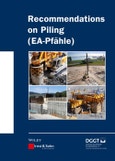- categorisation of piling systems,
- actions on piles from structural loading, negative skin friction and side pressure,
- pile resistances from static and dynamic pile test loading as well as extensive tables with the pile load-bearing capacity of nearly all piling systems based on values from practical experience,
- pile groups,
- performance of static and dynamic test loading and integrity tests,
- load-bearing behaviour and verifications for piles under cyclical, dynamic and impact actions
- quality assurance for construction.
An appendix with numerous calculation examples completes the work.
As part of the approval procedure for offshore wind energy structures, the Federal Office for Shipping and Hydrography (BSH) demands verifications according to the new Chapter 13 ("Load-bearing behaviour and verifications for piles under cyclical, dynamical and impact actions") of the EA Pfahle (the recommendations of the Piling working group - 2nd edition), which deals with external pile resistance for the foundations of offshore wind energy structures and the types of verifications to be provided under cyclical actions.
The publication of the EA-Pfahle recommendations by the Piling working group of the German Society for Geotechnics (DGGT), which works with the same members as the piling standards committee NA 00-05-07, is intended to provide assistance for engineers active in the design, calculation and construction of piled foundations. The recommendations can thus be considered as rules of the technology and as a supplement to the available codes and standards.
Table of Contents
Members of the AK 2.1 Piling Committee of the German Geotechnical Society V
Preface of the English Version of the Recommendations of the Piling Committee of the German Geotechnical Society VII
Preface of the 2nd German edition IX
1 Introduction to the Recommendations and their Application Principles 1
1.1 National and International Regulations for Piling Works 1
1.2 Types of Analysis and Limit States using the Partial Safety Factor Approach 2
1.3 Planning and Testing Pile Foundations 7
2 Pile Systems 9
2.1 Overview and Classification into Pile Systems 9
2.2 Pile Construction 12
2.3 Foundation elements similar to piles 25
3 Pile Foundation Design and Analysis Principles 27
3.1 Pile Foundation Systems 27
3.2 Geotechnical Investigations for Pile Foundations 32
3.3 Classification of Soils for Pile Foundations 39
3.4 Pile Systems for the Execution of Excavations and for Retaining Structures 40
3.5 Piles for the Stabilisation of Slopes 43
3.6 Use of sacrificial Linings 44
4 Actions and Effects 47
4.1 Introduction 47
4.2 Pile Foundation Loads Imposed by the Structure 48
4.3 Installation Effects on Piles 48
4.4 Negative Skin Friction 49
4.5 Lateral Pressure 54
4.6 Additional Effects on Raking Piles Resulting from Ground Deformations 62
4.7 Foundation Piles in Slopes and at Retaining Structures 65
5 Bearing Capacity and Resistances of Single Piles 69
5.1 General 69
5.2 Determining Pile Resistances from Static Pile Load Tests 70
5.3 Determining Pile Resistances from Dynamic Pile Load Tests 72
5.4 Axial Pile Resistances Based on Empirical Data 75
5.5 Bored Piles with Enlarged Bases 113
5.6 Additional Methods Using the EC 7-1 and EC 7-2 Handbooks 114
5.7 Pile Resistances for Grouted Shafts and Bases. 114
5.8 Resistances of Piles Under Lateral Loads 115
5.9 Pile Resistances Under Dynamic Actions 116
5.10 Internal Pile Capacity 116
5.11 Numerical Analyses of the Capacity of Single Piles 119
6 Stability Analyses 121
6.1 Introduction 121
6.2 Limit State Equations 121
6.3 Bearing Capacity Analysis 122
6.4 Serviceability Analysies 125
6.5 Pile Groups and Grillages 127
6.6 Piled Raft Foundations 127
7 Grillage Analysis 129
7.1 AnalysisModels and Procedures 129
7.2 Non-linear Pile Bearing Behaviour in Grillage Analysis 130
8 Analysis and Verification of Pile Groups 131
8.1 Actions and Effects 131
8.2 Bearing Capacity and Resistances of Pile Groups 133
8.3 Bearing Capacity Analyses 152
8.4 Serviceability Analyses 156
8.5 Higher Accuracy Pile Group Analyses 157
9 Static Pile Load Tests 159
9.1 Introduction 159
9.2 Static Axial Pile Load Tests 159
9.3 Static Lateral Load Test 182
9.4 Static Axial Load Tests on Micropiles (Composite Piles) 194
10 Dynamic pile load tests 209
10.1 Introduction. 209
10.2 Range of Application and General Conditions 209
10.3 Theoretical Principles 210
10.4 Description of Testing Methods, Test Planning and Execution 213
10.5 Evaluation and Interpretation of Dynamic Load Tests 225
10.6 Calibrating Dynamic Pile Load Tests 231
10.7 Qualifications of Testing Institutes and Personnel 234
10.8 Documentation and Reporting 234
10.9 Testing Driving Rig Suitability 236
11 Quality Assurance during Pile Execution 239
11.1 Introduction. 239
11.2 Bored Piles 239
11.3 Displacement Piles 253
11.4 Grouted Micropiles (Composite Piles). 255
12 Pile Integrity Testing 259
12.1 Purpose and Procedures 259
12.2 Low Strain Integrity Tests 260
12.3 Ultrasonic Integrity Testing 270
12.4 Testing Piles by Core Drilling. 279
12.5 Other Specific TestingMethods 282
13 Bearing Capacity and Analyses of Piles under Cyclic, Dynamic and Impact Actions 285
13.1 Introduction 285
13.2 Cyclic, Dynamic and Impact Actions 286
13.3 Supplementary Geotechnical Investigations 292
13.4 Bearing Behaviour and Resistances under Cyclic Loads 294
13.5 Bearing Behaviour and Resistances under Dynamic Loads 299
13.6 Bearing Behaviour and Resistances under Impact Loads 300
13.7 Stability Analyses of Cyclic, Axially Loaded Piles 301
13.8 Stability Analyses of Cyclical, Laterally Loaded Piles 304
13.9 Stability Analyses of Dynamic or Impact-loaded Piles 306
Annex A Terms, Partial Safety Factors and Principles for Analysis 307
Annex B Example Calculations for Pile Resistance Analysis and Verifications 331
Annex C Examples of Dynamic Pile Load Testing and Integrity Testing 395
Annex D Analysis Methods and Examples for Cyclically Loaded Piles (Informative) 417
Literatur 459
List of Advertisers 469








